Hey fellas, I've recently seen some awesome US AFVs that are being scratch built and/or kit bashed and it's got me really thinking about trying my hand at doing one. The problem is, I've never done anything like this. I've never used or bought any evergreen plastic. I don't even know how you'd even know what size/thickness to buy to even try to start something. I'm not even good with PE. But I don't want this to hold me back from trying something new.
Can any of you scratch builders or kitbashers give a noob some pointers here please?
Thanks
Armor/AFV
For discussions on tanks, artillery, jeeps, etc.
For discussions on tanks, artillery, jeeps, etc.
Hosted by Darren Baker, Mario Matijasic
Scratch building and/or kit bashing.
Thirian24

Joined: September 30, 2015
KitMaker: 2,493 posts
Armorama: 2,344 posts

Posted: Thursday, January 18, 2018 - 10:01 PM UTC
Posted: Thursday, January 18, 2018 - 10:18 PM UTC
Dustin I am sure you are already aware of this "Conversions and Scratch Builds Thread":
https://armorama.kitmaker.net/forums/248425
Best of luck on your new effort.
Mike
https://armorama.kitmaker.net/forums/248425
Best of luck on your new effort.
Mike
rmadfire1

Joined: August 26, 2009
KitMaker: 265 posts
Armorama: 263 posts

Posted: Thursday, January 18, 2018 - 10:18 PM UTC
Dustin,
I've scratch built tons of models and really the only way is to just start. This aspect of modeling takes practice and patients. Good measuring skills are a must, so good stainless steel rulers are essential along with blades and handles, I like xacto stainless steel blades. Start building little things to get the hang of it.
DJ
I've scratch built tons of models and really the only way is to just start. This aspect of modeling takes practice and patients. Good measuring skills are a must, so good stainless steel rulers are essential along with blades and handles, I like xacto stainless steel blades. Start building little things to get the hang of it.
DJ
seanmcandrews

Joined: May 09, 2009
KitMaker: 561 posts
Armorama: 553 posts

Posted: Thursday, January 18, 2018 - 10:21 PM UTC
Hi Dustin,
It's an oldy but a goody, pick up a copy of Shep Paine's "Modeling Tanks & Military Vehicles"
https://www.amazon.com/Modeling-Tanks-Military-Vehicles-Shepard/dp/0890240450
it's got a whole chapter on the very basics of scratch building and still holds up very well after all these years in my opinion.
Evergreen offers variety packs of various thicknesses styrene sheet, get yourself some and start cutting away !
Sean
It's an oldy but a goody, pick up a copy of Shep Paine's "Modeling Tanks & Military Vehicles"
https://www.amazon.com/Modeling-Tanks-Military-Vehicles-Shepard/dp/0890240450
it's got a whole chapter on the very basics of scratch building and still holds up very well after all these years in my opinion.
Evergreen offers variety packs of various thicknesses styrene sheet, get yourself some and start cutting away !
Sean
pjmurley

Joined: July 06, 2014
KitMaker: 63 posts
Armorama: 52 posts

Posted: Thursday, January 18, 2018 - 10:24 PM UTC
Scratch building requires some basic tools- you should get a few basic ones to start. I would suggest getting a couple of small squares, a good ruler, a protractor and a compass, some small clamps and of course a good knife. I prefer OLfa knives for scratch building.
Another thing you will need to learn is styrene thickness which is measured in thousands of an inch. A good understanding is essential.
Start with something you know you can finish and have fun, because that's what its all about.
Another thing you will need to learn is styrene thickness which is measured in thousands of an inch. A good understanding is essential.
Start with something you know you can finish and have fun, because that's what its all about.
Posted: Thursday, January 18, 2018 - 10:25 PM UTC
I am blessed with having two local hobby shops that are both well stocked with Evergreen and Plastistrut.
Hard to recommend popular sizes of these two products as selecting certain sizes really depends on what you are trying to build.
Over time you will build up a collection of these building materials to have on hand.
Hard to recommend popular sizes of these two products as selecting certain sizes really depends on what you are trying to build.
Over time you will build up a collection of these building materials to have on hand.
Posted: Thursday, January 18, 2018 - 11:41 PM UTC
Dustin, my 2 cents would be:
-remember, even the most complicated feature can be dissected to basic geometry shapes.So you will need styren rods, channels,square tubes and most of all-sheets.Do not expect to buy everything you mignt need at once- it is a trial and error process.
-it has been said- pick a simple feature, scratch it and have fun.Your confidence will grow with every other scratch.Keep having fun, because this is basically what it is all about.
-you will need good tools.Don't jump at the most expensive ones in the beginning.But be prepare to spend some money on tools.Having good tools will give you the opportunity to build more elaborated features, thus paying off by giving you more elaborated fun.
-nothing is impossible to scratchbuild.It is just a matter of time,research,dedication-because frustration might be a frequent visitor-and resolve.
We have a Scratch Builder Campaign in approval process.
I would love to see you taking part
https://armorama.kitmaker.net/forums/263897&page=1

-remember, even the most complicated feature can be dissected to basic geometry shapes.So you will need styren rods, channels,square tubes and most of all-sheets.Do not expect to buy everything you mignt need at once- it is a trial and error process.
-it has been said- pick a simple feature, scratch it and have fun.Your confidence will grow with every other scratch.Keep having fun, because this is basically what it is all about.
-you will need good tools.Don't jump at the most expensive ones in the beginning.But be prepare to spend some money on tools.Having good tools will give you the opportunity to build more elaborated features, thus paying off by giving you more elaborated fun.
-nothing is impossible to scratchbuild.It is just a matter of time,research,dedication-because frustration might be a frequent visitor-and resolve.
We have a Scratch Builder Campaign in approval process.
I would love to see you taking part
https://armorama.kitmaker.net/forums/263897&page=1

Posted: Friday, January 19, 2018 - 12:51 AM UTC
Angel - well said.
RLlockie

Joined: September 06, 2013
KitMaker: 1,112 posts
Armorama: 938 posts
Posted: Friday, January 19, 2018 - 02:39 AM UTC
Start with something simple like a box. Do a rough 3D sketch of it with the thicknesses of each face indicated so that you know which faces will sit inside which others. Donít bother with chamfering edges at this stage. For example, if you were building a box that is 10mm on each side from 0.5mm sheet, you might cut a strip that is 10mm side and chop it into four 10mm x 9.5mm pieces. These might form the four sides, each of which overlaps one edge of the next. The top and bottom could then be cut from any thickness you like as they will fit inside the hollow tube you have just built, so need to be 1mm undersized in both directions, so 9mm square. Armed with all the parts, I would build up the walls round the base using sparing amounts of liquid cement, then when you have an open-topped box, let it set and pop it over the other 9mm square, which it should fit. More cement and leave to dry.
There is obviously lots more to consider such a structural reinforcement, details etc but doing something simple well will give you confidence to progress. Expect to have to have several tries at some projects - even David Parker, who builds amazing stuff, has to junk some assemblies and start again sometimes. Just donít expect to emulate him or scratchbuild a railway gun as your first project.
There is obviously lots more to consider such a structural reinforcement, details etc but doing something simple well will give you confidence to progress. Expect to have to have several tries at some projects - even David Parker, who builds amazing stuff, has to junk some assemblies and start again sometimes. Just donít expect to emulate him or scratchbuild a railway gun as your first project.
Posted: Friday, January 19, 2018 - 02:49 AM UTC
No argument here against the point made above but I do want to interject: I have found that building an exact box is probably one of the hardest things a newbie could attempt "right out of the box". So many subtile ways to go wrong unless your precision is highly exact.
To this day I build tool boxes, gas tanks, etc. out of a solid mass of square plastic tubing to guarantee squareness and then cover them with sheet plastic.
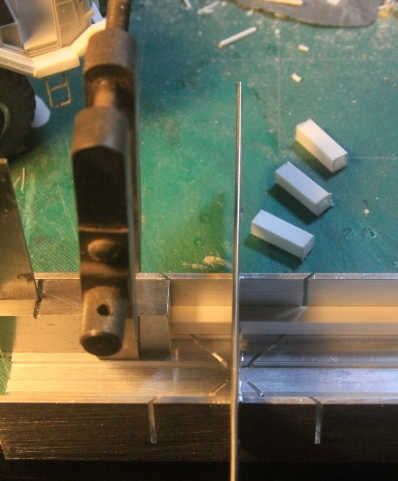
Made a very simple cutting jig using my mitre box and a C-clamp, to produce roughly equal lengths of square tubing.
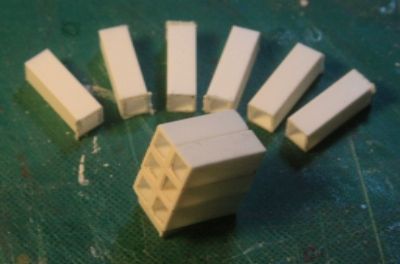
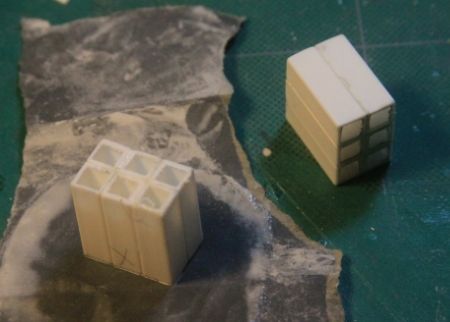
Glue tubes together and then sand so all tubes are of an equal length and finally cover them with thin plastic sheet.

These rear mounted tool boxes were the desired finished product.
To this day I build tool boxes, gas tanks, etc. out of a solid mass of square plastic tubing to guarantee squareness and then cover them with sheet plastic.

Made a very simple cutting jig using my mitre box and a C-clamp, to produce roughly equal lengths of square tubing.


Glue tubes together and then sand so all tubes are of an equal length and finally cover them with thin plastic sheet.

These rear mounted tool boxes were the desired finished product.
Thirian24

Joined: September 30, 2015
KitMaker: 2,493 posts
Armorama: 2,344 posts

Posted: Friday, January 19, 2018 - 08:06 AM UTC
Thank you guys for the awesome replay. As always, such a great community.
I found some pictures online awhile back, that someone had built a tracked Stryker. I've. Ever seen the finished pictures, but he used an AFV Club upper hull and a Tamiya Bradley lower hull and running gear. Looks like he also used some challenger 2 ERA.
Not that I'm trying to steal someone else's idea, but I LOVE this thing and I'd like to try and build my one.
Have any of you ever seen this before? I'll share a link, I uploaded it to Imgur.
https://imgur.com/gallery/hJwVB
I found some pictures online awhile back, that someone had built a tracked Stryker. I've. Ever seen the finished pictures, but he used an AFV Club upper hull and a Tamiya Bradley lower hull and running gear. Looks like he also used some challenger 2 ERA.
Not that I'm trying to steal someone else's idea, but I LOVE this thing and I'd like to try and build my one.
Have any of you ever seen this before? I'll share a link, I uploaded it to Imgur.
https://imgur.com/gallery/hJwVB
TankManNick

Joined: February 01, 2010
KitMaker: 551 posts
Armorama: 543 posts

Posted: Friday, January 19, 2018 - 09:36 AM UTC
Quoted Text
To this day I build tool boxes, gas tanks, etc. out of a solid mass of square plastic tubing to guarantee squareness and then cover them with sheet plastic.
Genius!

RLlockie

Joined: September 06, 2013
KitMaker: 1,112 posts
Armorama: 938 posts
Posted: Friday, January 19, 2018 - 01:10 PM UTC
Well I donít disagree with that approach for small solid boxes but there are also shapes that are box-like but much bigger, hollow or open, such as truck bodies. If you havenít mastered the principles of building smaller boxes (which consume less styrene sheet while you are learning), the larger ones will be frustrating when the parts donít fit. Itís worth spending a decent amount of thinking and planning time before cutting anything and you can do that in the car, on the train or possibly even at work!

m4sherman

Joined: January 18, 2006
KitMaker: 1,866 posts
Armorama: 1,808 posts

Posted: Friday, January 19, 2018 - 07:50 PM UTC
Robert brings up a good point. I think what he is saying is to visualize what you want to make.
If I have a project I put all the pieces into an idea and run it through my head for a while. Usually at work. Keeping in mind that sometimes the idea runs into reality. Don't be afraid to start over. A box with a bad angle can be fixed, but it is often easier to just make a new box.
The bustle on the Sherman/Panther took several tries before I liked the look.
If I have a project I put all the pieces into an idea and run it through my head for a while. Usually at work. Keeping in mind that sometimes the idea runs into reality. Don't be afraid to start over. A box with a bad angle can be fixed, but it is often easier to just make a new box.
The bustle on the Sherman/Panther took several tries before I liked the look.
Biggles2

Joined: January 01, 2004
KitMaker: 7,600 posts
Armorama: 6,110 posts

Posted: Friday, January 19, 2018 - 08:39 PM UTC
You're also going to need a reliable and accurate set of scale plans or drawings.



TopSmith

Joined: August 09, 2002
KitMaker: 1,742 posts
Armorama: 1,658 posts

Posted: Friday, January 19, 2018 - 11:00 PM UTC
1. Do not get in a hurry.
2. There is usually more than one way to do it.
3. Designing/ building/ redesigning is not simple and frequently a better way materializes during the build.
4. Ask for advice. It may or may not be helpful but can lead you to the best answer.
5. Develop a resource stream.
6. Failure is learning in action. Failure is different than quiting. Expect multiple attempts.
2. There is usually more than one way to do it.
3. Designing/ building/ redesigning is not simple and frequently a better way materializes during the build.
4. Ask for advice. It may or may not be helpful but can lead you to the best answer.
5. Develop a resource stream.
6. Failure is learning in action. Failure is different than quiting. Expect multiple attempts.
petbat

Joined: August 06, 2005
KitMaker: 3,353 posts
Armorama: 3,121 posts

Posted: Saturday, January 20, 2018 - 02:01 AM UTC
Quoted Text
Not that I'm trying to steal someone else's idea, but I LOVE this thing and I'd like to try and build my one.
Combining kits can be one of the most challenging aspects of scratch building. It would be very rare that an upper hull of one fit the lower of another, so there will be a lot of work to determine what is need to blend it together. In this case the fenders are used as a medium for location, but I expect there will be bracing inside the hull to ensure rigidity, etc. Whilst the front has been fitted to mate each other, I imagine the rear needed a lot of work. This is where planning, considering options, test fitting, etc is essential.
This type of 'what if' build means you cannot get plans to work from, so it is all down to planning. As per previous comments, be prepared to throw a few attempts out when you do major assemblies, especially like this.
I would follow the advice of the others and do some basic builds first to develop the skills. A box is a very basic shape, but you will learn it is not as easy as it looks. Making sides that are perfect rectangles exactly the same size and then the rectangle for a floor that fits perfectly inside, is testing. Even using the square tube method requires some skill to ensure the sanding of the ends leaves the whole assembly square.
Don't let it scare you though. It is very rewarding seeing what you can accomplish.
KelticKnot

Joined: May 11, 2015
KitMaker: 768 posts
Armorama: 12 posts

Posted: Saturday, January 20, 2018 - 02:36 AM UTC
I'd recommend Evergreen's assorted packs as a great starting point to experiment with before you start getting specifically sized packs.
The assorted sheet (#9008 is it's code) has three thickness's of sheet that will cover a multitude of uses.
The assorted rods and tubes ( #217 ) pack will give you a bunch of different diameter pieces.
Unless you're planning to scratchbuild very large objects these will last you quite a few models.
Angel's first point is the most important i think : look for the basic geometry in anything you're making and combine or build on those rather than trying to make complex shapes from the start.
Good Luck !
The assorted sheet (#9008 is it's code) has three thickness's of sheet that will cover a multitude of uses.
The assorted rods and tubes ( #217 ) pack will give you a bunch of different diameter pieces.
Unless you're planning to scratchbuild very large objects these will last you quite a few models.
Angel's first point is the most important i think : look for the basic geometry in anything you're making and combine or build on those rather than trying to make complex shapes from the start.
Good Luck !

Posted: Saturday, January 20, 2018 - 03:27 AM UTC
Dustin
Just a suggestion: How bout we turn this thread into a "tips and tricks for scratch building" thing?
I have at least two more "how to" tricks I would like to share.
Just a suggestion: How bout we turn this thread into a "tips and tricks for scratch building" thing?
I have at least two more "how to" tricks I would like to share.
Thirian24

Joined: September 30, 2015
KitMaker: 2,493 posts
Armorama: 2,344 posts

Posted: Saturday, January 20, 2018 - 03:50 AM UTC
Michael, that's fine by me, sir!
I have a Tamiya Bradley and an LAV-III at home. I'll stick the upper and lower hulls together and see what they look like and perhaps what it might take to mate them together. Although.. I'm about a week and a half out from being home still. Lol
I have a Tamiya Bradley and an LAV-III at home. I'll stick the upper and lower hulls together and see what they look like and perhaps what it might take to mate them together. Although.. I'm about a week and a half out from being home still. Lol

rdt1953

Joined: February 06, 2015
KitMaker: 1,098 posts
Armorama: 68 posts

Posted: Saturday, January 20, 2018 - 06:38 AM UTC
Dustin - It is very helpful to have a dead flat surface to work on - a piece of plate glass is ideal. To keep things square I like to use precision ground machinist's blocks on the glass plate . These are available in a variety of sizes from machinist supply sellers such as Enco. Expensive but you only need a few and they will last forever. Here is the bed I built for a 1/48 scale Japanese Hucks type airfield starter truck converted from Hasegawa's Isuzu trucks-
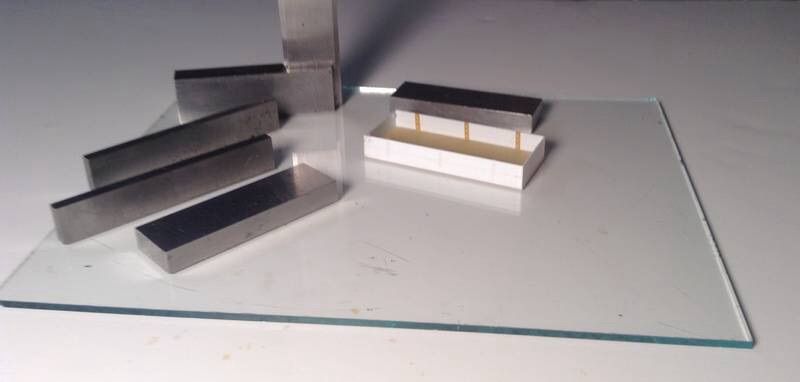
Soldering is another important skill for scratch building - when creating very fine objects plastic is often too weak and the very small joints are weak as well - brass is easily worked and the soldering is easily learned with just a little practice. The big difference is you must contrive fixtures to hold the components in the proper relationship to each other while soldering, either by iron or torch. Here is one side of the mast for the Hucks Truck in it's fixture -

Here is the truck very well along -
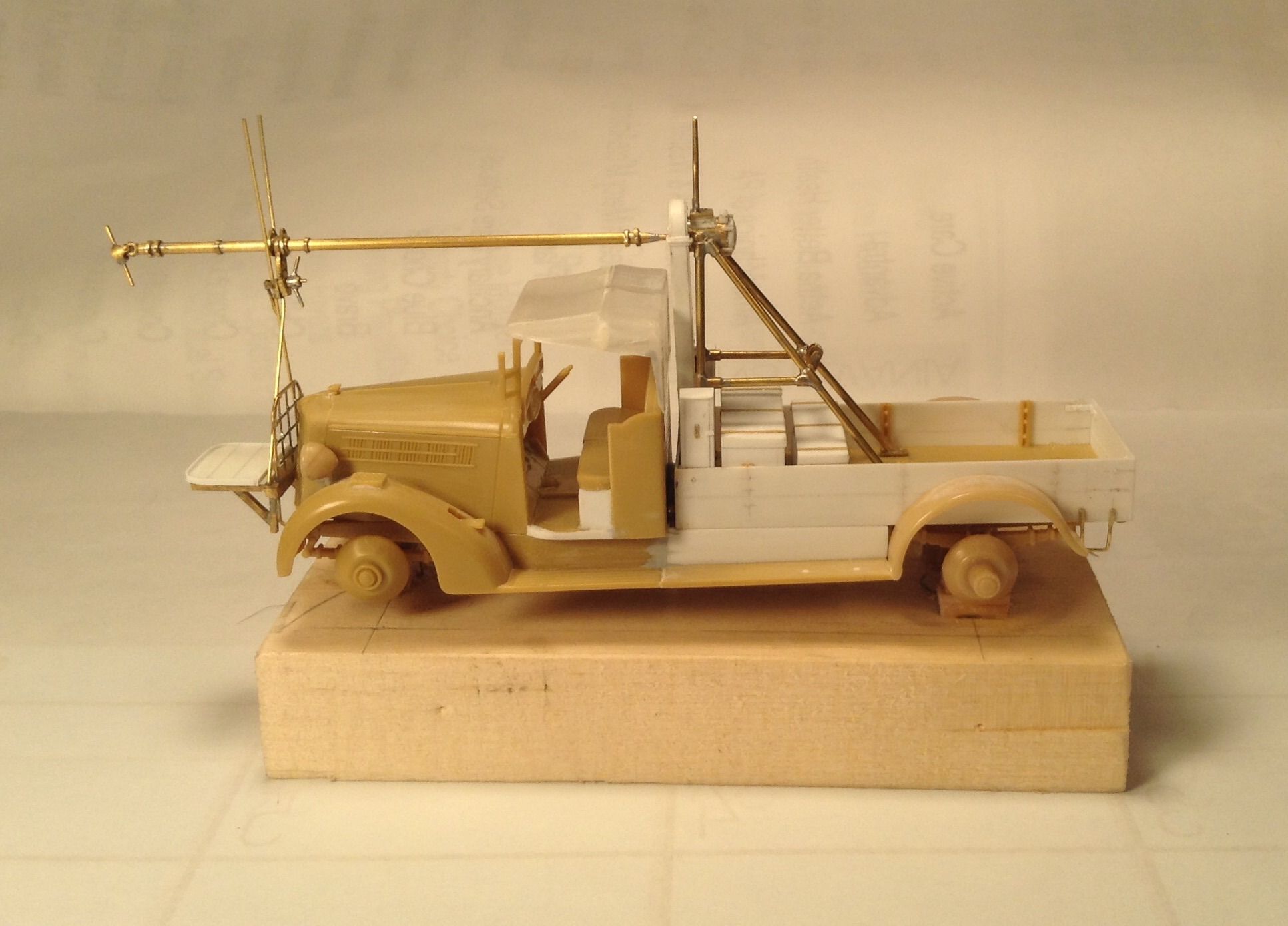
The entire build was documented on Aeroscale but unfortunately lost to the Photobucket disaster.
Here is a current effort - 1/48 Japanese tailwheel dolly that will be part of a Ki 43 Hayabusa diorama -
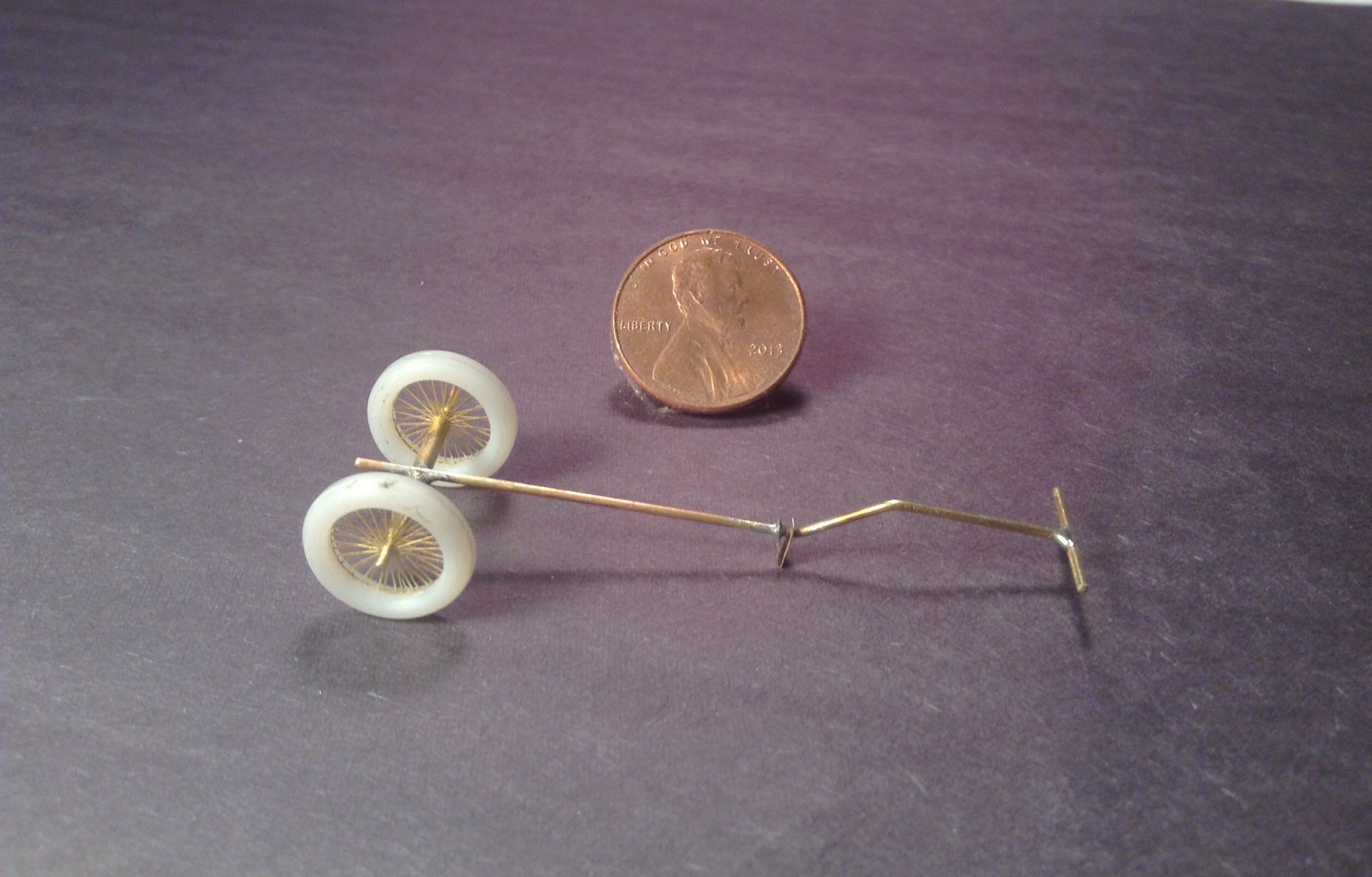
Go for it - make mistakes and learn - you won't regret it .
Cheers - Richard

Soldering is another important skill for scratch building - when creating very fine objects plastic is often too weak and the very small joints are weak as well - brass is easily worked and the soldering is easily learned with just a little practice. The big difference is you must contrive fixtures to hold the components in the proper relationship to each other while soldering, either by iron or torch. Here is one side of the mast for the Hucks Truck in it's fixture -

Here is the truck very well along -

The entire build was documented on Aeroscale but unfortunately lost to the Photobucket disaster.
Here is a current effort - 1/48 Japanese tailwheel dolly that will be part of a Ki 43 Hayabusa diorama -

Go for it - make mistakes and learn - you won't regret it .
Cheers - Richard
Posted: Saturday, January 20, 2018 - 09:48 AM UTC
I work on a piece of marble I have laying around, same thing.
I had not thought about the machinist blocks but I will fix that oversight shortly. Thanks for the suggestion. I could have used them just tonight!
I had not thought about the machinist blocks but I will fix that oversight shortly. Thanks for the suggestion. I could have used them just tonight!

Jmarles

Joined: November 02, 2008
KitMaker: 1,138 posts
Armorama: 953 posts

Posted: Saturday, January 20, 2018 - 10:04 AM UTC
There's a lot of trial and error, that's for sure. Materials you will need are Plastruct and Evergreen strips, sheet, tubes, etc. I started off small and simple : adding jerrycan racks, toolboxes, crates, building elements, etc. I then moved on to simple conversions like turning the UE tractor into an armoured MG version, etc. Eventually I got to the point where I recently built a little armoured railcar and am moving on to a bigger one. A strong metal ruler, a right angle, very sharp blades, compass, scale ruler, sandpaper, etc. are useful items. For smaller plastic I use Xacto and razor blades. For thicker stuff, I use Olfa knives which are super super sharp. For things like boxes I "cheat" and use square beams to keep edges true. The carpentry adage "Measure twice, cut once" certainly is apt. 




m4sherman

Joined: January 18, 2006
KitMaker: 1,866 posts
Armorama: 1,808 posts

Posted: Sunday, January 21, 2018 - 01:28 AM UTC
If you use a glass plate try to get a piece that is tempered glass. I got a kitchen cutting board that does the job for me. It probably won't survive if dropped, but won't break under pressure.
Shalta

Joined: August 23, 2016
KitMaker: 165 posts
Armorama: 160 posts

Posted: Sunday, January 21, 2018 - 01:45 AM UTC
So... Relevant to this post, is it at ALL possible for a person with no experiance to 100% scratchbuild a full tank and have a good result?
I'm interested in a few light tank prototypes (Mostly the M8 AGS and XM800T), but the chance of seeing a plastic kit of any of them looks nearly hopeless.
I assume itd be a slow process, with alot of trial and error, but I'm just wondering if it's even viable to try.
I'm interested in a few light tank prototypes (Mostly the M8 AGS and XM800T), but the chance of seeing a plastic kit of any of them looks nearly hopeless.
I assume itd be a slow process, with alot of trial and error, but I'm just wondering if it's even viable to try.
 |
















